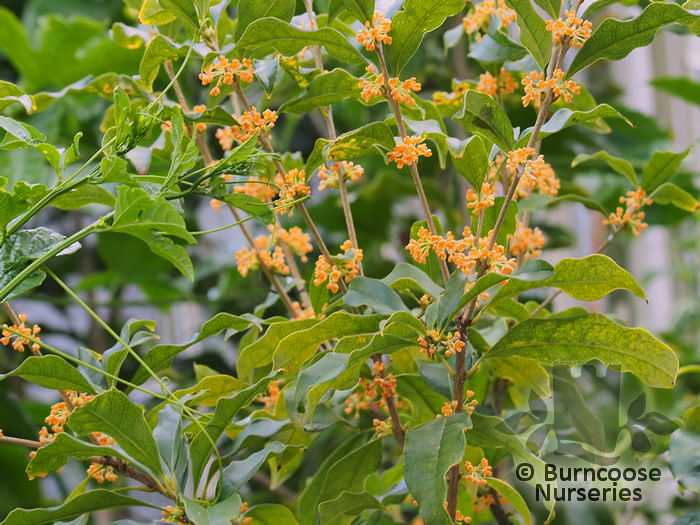OSMANTHUS fragrans f.aurantiacus

<




>
OSMANTHUS fragrans f.aurantiacus
Commonly known as Fragrant olive, Sweet tea
Deliciously scented clusters of orange flowers followed by black fruits. Tender
Full Plant Details - Sun/Soil & other attributes
-
Floweringlocal_floristJanlocal_floristFeblocal_floristMarlocal_floristAprlocal_floristMaylocal_floristJunlocal_floristJullocal_floristAuglocal_floristSeplocal_floristOctlocal_floristNovlocal_floristDec
-
BerriesThese plants have berries.
-
 Good to know
Sometimes flowers in spring, summer and autumn
Good to know
Sometimes flowers in spring, summer and autumn -
 Pests & Diseases
Trouble free
Pests & Diseases
Trouble free -
 Place of origin
Himalayas, China
Place of origin
Himalayas, China -
EvergreenOblong to oblong-lance-shaped, leathery leaves 10-12cm (4-4¾in) long
-
TubularLobes to 1cm (½in) across
-
Frost hardy (down to -5)
-
 Height
6m (20ft)
Height
6m (20ft) -
 Spread
6m (20ft)
Spread
6m (20ft) -
Tall ShrubVigorous, upright shrub or small tree. Flowers are produced singly or in few-flowered axillary clusters. Fruit to 1cm (½in) long.
-
 Pruning group 6
Suitable for: Evergreen shrubs or climbers that need little to no pruning.
Pruning group 6
Suitable for: Evergreen shrubs or climbers that need little to no pruning.
Action: Trim back shoots that spoil symmetry and to fit available space.
When: Annually after flowering if on previous year's growth, or in later Winter or Spring if flowering on current year's growth, or as requires.
-
 Half hardy - unheated greenhouse / mild winter
Hardy in coastal and relatively mild parts of the UK except in severe winters and a risk from sudden (early) frosts. May be hardy elsewhere with wall shelter or good micro-climate. Likely to be damaged or killed in cold winters. Plant can withstand temperatures down to -5°C (23°F)
Half hardy - unheated greenhouse / mild winter
Hardy in coastal and relatively mild parts of the UK except in severe winters and a risk from sudden (early) frosts. May be hardy elsewhere with wall shelter or good micro-climate. Likely to be damaged or killed in cold winters. Plant can withstand temperatures down to -5°C (23°F) -
Scented flowersVery fragrant
-
Autumn Seasonal Interest
-
Fertile well drained soil
-
 Full sun
Full sun
-
 Partial shade
Partial shade
-
Mature Size6m (20ft)


6m (20ft)
View Detailed Plant Description
View Planting Tips and Care Advice
Osmanthus - Growing Guide






